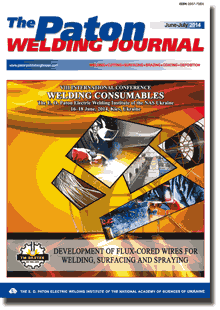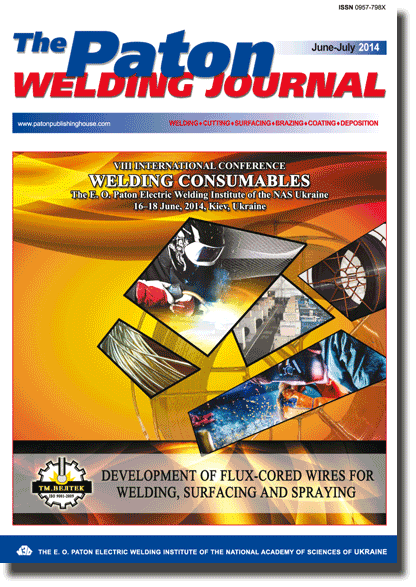Access for download PDF files for subscribers and for reviewers of scientometric bases.
Organization: Elsevier for content access(PDF files of journals released before 2024 are available for download from the website's archives))
Organization: Elsevier for content access(PDF files of journals released before 2024 are available for download from the website's archives))
| 2014 №06 (02) |
DOI of Article 10.15407/tpwj2014.06.03 |
2014 №06 (04) |

The Paton Welding Journal, 2014, #6-7, 14-21 pages
APPLICATION OF SHIELDING GASES IN WELDING PRODUCTION (REVIEW)
B.E. PATON, S.T. RIMSKY and V.I. GALINICH
E.O. Paton Electric Welding Institute, NASU. 11 Bozhenko Str., 03680, Kiev, Ukraine. E-mail: office@paton.kiev.ua
Abstract
Main welding-technological properties of pure shielding gases and gas mixtures in consumable and non-consumable welding of different materials were analyzed. It is outlined that knowledge of properties of shielding gas components allows their efficient selection from point of view of welding process optimizing, increase of quality indices and service properties of welded parts, improvement of conditions of work and rise of its efficiency as well as providing of environmental safety of the works. A conclusion is made based on given data that arc method will remain one of the leading technological processes of material joining in the near and far future. 34 Ref., 3 Tables, 3 Figures.
Keywords: arc welding, consumable and non-consumable electrodes, pure gases, compositions of gas mixtures, welding methods, fields of application, materials to be welded
Received: 11.04.14
Published: 28.09.14
References
1. Lyubavsky, K.V., Novozhilov, N.M. (1953) Consumable-electrode shielded-gas welding. Avtogen. Delo, 1, 4-8.
2. Novozhilov, N.M., Sokolova, A.M. (1958) Development of electrode wires for CO2 welding of low-carbon and low-alloy steels. Svarochn. Proizvodstvo, 7, 10-14.
3. Paton, B.E., Potapievsky, A.G., Podola, N.V. (1964) Consumable electrode pulsed arc welding with program control of process. Avtomatich. Svarka, 1, 1-6.
4. Paton, B.E., Voropaj, N.M., Buchinsky, V.N. et al. (1977) Control of arc welding process by programming of electrode wire feed rate. Ibid., 1, 1-5, 15.
5. Paton, B.E., Lebedev, A.V. (1988) Control of melting and electrode metal transfer in CO2 welding. Ibid., 11, 1-5.
6. Paton, B.E., Kirsanov, A.V., Podgaetsky, V.V. et al. Shielding gas mixture. USSR author's cert. 448106. Int. Cl. B 23 K 35/38. Prior. 26.06.72. Publ. 30.10.74.
7. Svetsinsky, V.G., Rimsky, S.T., Galinich, V.I. (1994) Welding of steels in shielding argon-based gas mixtures on in industry of Ukraine. Avtomatich. Svarka, 4, 41-44.
8. Svetsinsky, V.G., Rimsky, S.T., Kirian, V.I. (1992) Evaluation of fracture toughness of welds made in shielding gases and by submerged-arc process. Ibid., 8, 16-19.
9. Lucas, W. (1992) Choosing a shielding gas. Pt 2. Weld. and Metal Fabr., 6, 269-276.
10. Dilthey, U., Reisgen, U., Stenke, V. et al. Schutzgase zum MAGM-Hochleistungsschweissen. Schweissen und Schneiden, 47(2), 118-123.
11. Dixon, K. (1999) Shielding gas selection for GMAW of steels. Weld. and Metal Fabr., 5, 8-13.
12. Salter, G.R., Dye, S.A. (1971) Selecting gas mixtures for MIG welding. Metal Constr. and British Welding J., 3(6), 230-233.
13. Cresswell, R.A. (1972) Gases and gas mixtures in MIG and TIG welding. Weld. and Metal Fabr., 40(4), 114-119.
14. Ameye, M. (2011) Einfluss der verschiedenen Schutzgase im Zusammenwirken mit Schweissverfahren und Werkstoffen. Der Praktiker, 7, 271-273.
15. Kajdalov, A.A., Gavrik, A.N. (2011) Efficiency of application of shielding gas mixtures in arc welding of steels. Svarshchik, 4, 28-31.
16. Press, H., Florian, W. Formation of toxic substances in gas welding. Pt 2: Amount of toxic substances formed in the gas shielded welding processes MAG, MIG and GTA. IIW Doc. VIII-880-80.
17. Haas, B., Pomaska, H.U. (1980) Influence of process specific welding parameters on fume generation in solid wire GMA (MAG) welding. In: Proc. of IIW Col. on Welding and Health (Estoril, Portugal, 8 July, 1980), 8.
18. Levchenko, O.G. (1986) Influence of shielding gas composition and welding parameters on total emission of welding aerosol. Avtomatich. Svarka, 1, 73-74.
19. Kosiishi, F. (2007) Advanced welding consumables. J. JWS, 76(1), 61-64.
20. Stenbacka, N., Persson, K.-A. (1989) Shielding gases for gas metal arc welding. Welding J., 11, 41-47.
21. Lyttle, K., Stapon, G. (2005) Simplifying shielding gas selection. Practical Welding Today, 1, 22-25.
22. Ernst, M. (1999) Lichtbogen stabil gehalten. Produktion, 8, 23.
23. Urmston, S. (1996) Quality - all things to all welders. Weld. and Metal Fabr., 64(4), 150-152.
24. Church, J.G. Welding system. Pat. 4.463.143 USA. Publ. July 1984.
25. Lahnsteiner, P. (1991) T.I.M.E. - Process ein neues MAG-Schweissverfahren. Schweisstechnik, 12, 182-186.
26. Rimsky, S.T. (2011) Control of properties of the weld metal by regulating the level of oxidation of the weld pool in gas-shielded welding. The Paton Welding J., 12, 16-19.
27. Roshchupkin, N.P., Bliznets, N.A., Svetsinsky, V.G. et al. (1984) Experience of industrial application of shielding argon-based gas mixtures by All-Union plants «Soyuzstalkonstruktsiya». Avtomatich. Svarka, 3, 51-53.
28. (2001) SAGOS 3: Schutzgas fuer zwei Werkstoffgruppen. Stahlmarkt, 51(11), 66.
29. Pfeiffer, G. (1989) Zuend- und Spritzeruntersuchungen beim MAG-Impulsschweissen. ZIS-Mitteilungen, 31(6), 545-549.
30. Rimsky, S.T., Svetsinsky, V.G., Shejko, P.P. et al. (1993) Consumable electrode pulsed arc welding of low-alloy steels in argon mixture with CO2. Avtomatich. Svarka, 2, 38-41.
31. Rimsky, S.T. (2006) Manual on technology of shielded-gas mechanized welding. Kiev: Ekotekhnologiya.
32. (2005) Das Schutzgas machts. Blech. Rohre Profile, 52(8/9), 28-30.
33. Church, J.G., Imaizumi, H. Welding characteristics of a new welding TIME-process. IIW Doc. XII-1199.
34. Oeteren, K.-A. (1992) «Neues Schutzgas» metal-aktivgasgeschweisst - ein wirtschaftliher Vorteil? Der Praktiker, 2, 90-94.
Suggested Citation
B.E. PATON, S.T. RIMSKY and V.I. GALINICH (2014) APPLICATION OF SHIELDING GASES IN WELDING PRODUCTION (REVIEW). The Paton Welding J., 06, 14-21.The cost of subscription/purchase order journals or individual articles
| Journal/Currency | Annual Set | 1 issue printed |
1 issue |
one article |
| TPWJ/USD | 384 $ | 32 $ | 26 $ | 13 $ |
| TPWJ/EUR | 348 € | 29 € | 24 € | 12 € |
| TPWJ/UAH | 7200 UAH | 600 UAH | 600 UAH | 280 UAH |
| AS/UAH | 1800 UAH | 300 UAH | 300 UAH | 150 UAH |
| AS/USD | 192 $ | 32 $ | 26 $ | 13 $ |
| AS/EUR | 180 € | 30 € | 25 € | 12 € |
| SEM/UAH | 1200 UAH | 300 UAH | 300 UAH | 150 UAH |
| SEM/USD | 128 $ | 32 $ | 26 $ | 13 $ |
| SEM/EUR | 120 € | 30 € | 25 € | 12 € |
| TDNK/UAH | 1200 UAH | 300 UAH | 300 UAH | 150 UAH |
| TDNK/USD | 128 $ | 32 $ | 26 $ | 13 $ |
| TDNK/EUR | 120 € | 30 € | 25 € | 15 € |
AS = «Automatic Welding» - 6 issues per year;
TPWJ = «PATON WELDING JOURNAL» - 12 issues per year;
SEM = «Electrometallurgy Today» - 4 issues per year;
TDNK = «Technical Diagnostics and Non-Destructive Testing» - 4 issues per year.


